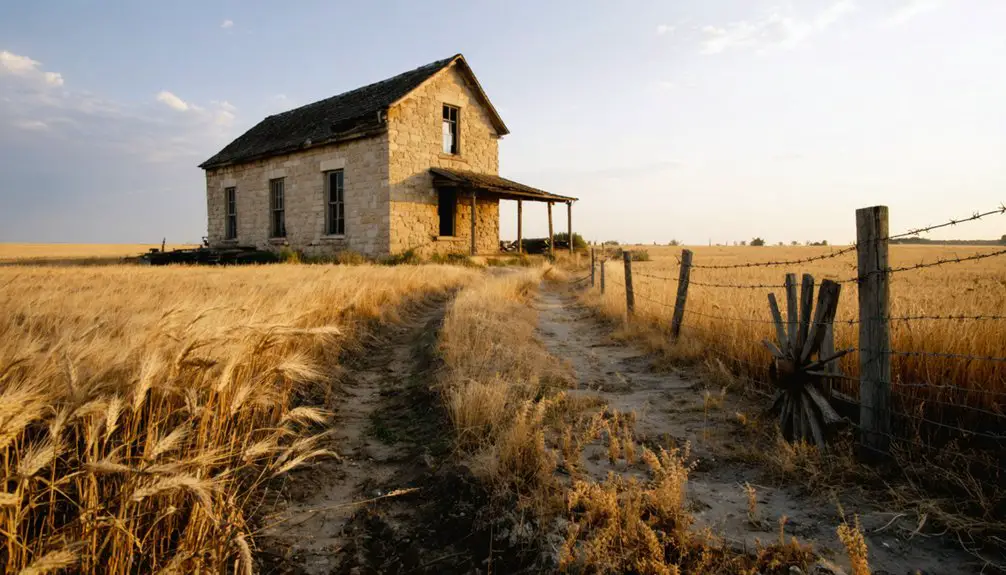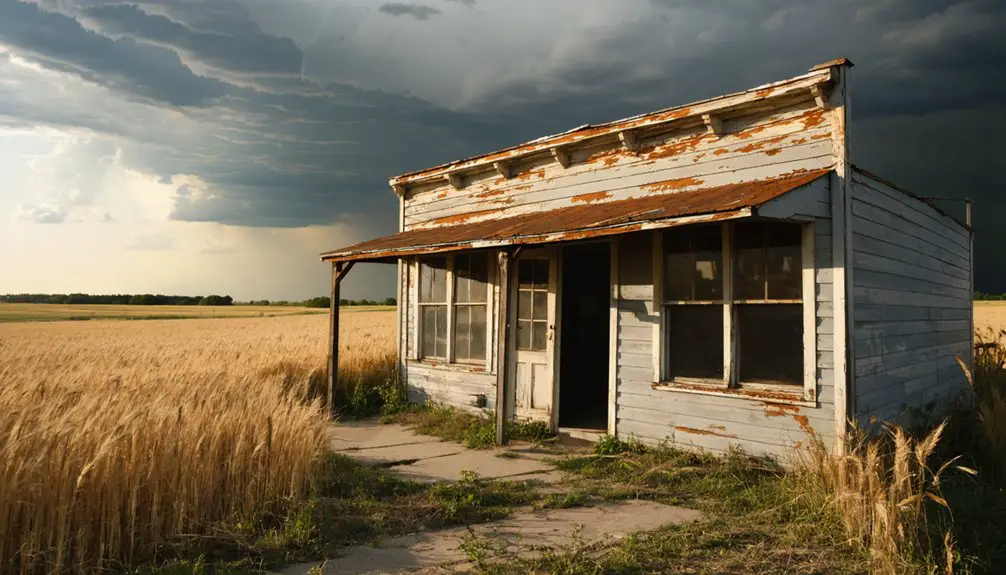You’ll find Chetolah’s remains along the Smoky Hill River in Ellis County, Kansas, where Thomas Fulgum founded this ambitious railroad town in 1886. The settlement featured a hotel, general store, and grain elevator during its brief heyday. Despite early promise and a diverse population of settlers, railroad investors, and gold seekers, Chetolah couldn’t survive when the Omaha, Dodge City & Southwestern Railroad failed to materialize in 1889. Its abandoned buildings tell a fascinating tale of frontier dreams and disappointments.
Key Takeaways
- Chetolah was established in 1886 as a railroad town but became a ghost town by 1900 after failing to secure crucial rail connections.
- The town’s economy collapsed after the promised Omaha, Dodge City & Southwestern Railroad failed to materialize in 1889.
- A failed 1893 gold rush and the closure of the post office in 1897 marked significant steps toward the town’s abandonment.
- Thomas Fulgum’s departure in 1889 and flooding concerns near the Smoky Hill River hindered further development of the settlement.
- Only building remnants remain today, serving as historical evidence of this frontier town’s brief existence in Pawnee Indian territory.
The Birth of a Prairie Settlement
When Thomas Fulgum founded Chetolah in 1886, he envisioned a thriving railroad town along the planned Omaha, Dodge City & Southwestern Railroad route.
You’ll find that settlement challenges emerged immediately, as pioneers worked to establish basic infrastructure in territory once inhabited by Pawnee Indians near the Smoky Hill River. The area’s rich history was shaped by railroad investors who sought to develop the Kansas prairie.
Despite the uncertainties, early community dynamics proved promising. Settlers quickly constructed a hotel, store, and grain elevator, while others built a distinctive horse track between two barns.
Determined pioneers brought civilization to the plains, raising vital buildings and even a racetrack between barns within months.
A.W. Copeland emerged as a key figure, managing the hotel and operating a general store. The relocated Palatine post office found its home in the Chetolah Hotel, marking the town’s growing importance. The town was officially incorporated in 1888 by the Chetolah Land and Town Company.
Even a false gold rush brought an influx of hopeful prospectors, temporarily boosting the settlement’s population and prospects.
Town Planning and Early Development
You’ll find Chetolah’s original town layout reflected ambitious plans for growth, with the 1880s design featuring a central business district anchored by a 12-room hotel and livery stable.
The town’s formal incorporation in 1888 coincided with the establishment of the Chetolah Town Site Company, which managed early development and secured the relocation of the Palatine post office to the hotel. Hill P. Wilson and other prominent local figures served as the original incorporators.
The founders’ vision included strategic infrastructure investments like a grain elevator and river bridge, though these developments were largely contingent on the anticipated arrival of the Omaha, Dodge City & Southwestern Railroad.
Initial Town Layout Plans
As the Chetolah Land and Town Company laid out its ambitious plans in 1887, the town’s design centered on the anticipated arrival of the Omaha, Dodge City & Southwestern Railroad line.
You’d have found a thoughtfully planned commercial hub featuring a 12-room hotel, general store, and grain elevator, all positioned to maximize the expected rail traffic.
The town layout incorporated practical infrastructure alongside entertainment, with a horse racing track between barns drawing settlers and visitors alike.
A bridge spanning the Smoky Hill River connected both sides of town, though its design faced challenges from the river’s notorious flash flooding.
The post office’s relocation from Palatine to the hotel’s premises created a centralized service hub, reflecting the company’s vision of a thriving frontier community.
Incorporation and Development Goals
The ambitious founding of Chetolah by Topeka investor Thomas Fulgum in 1886 marked the beginning of a carefully orchestrated town development plan.
You’ll find that town incorporation came in 1888 through the Chetolah Land and Town Company, with the post office’s relocation from Palatine cementing the town’s growing status.
Development aspirations centered on attracting the Omaha, Dodge City & Southwestern Railroad to transform Chetolah into a regional hub. Like many towns in Sar County, the founders envisioned becoming a railway junction point.
The town’s early infrastructure reflected these bold ambitions – you’d have seen a 12-room hotel, grain elevator, and general store rising from the prairie by 1887.
They even built a horse track and bridge over the Smoky Hill River, showing their commitment to both commerce and community life.
Life in Frontier Chetolah
Life in frontier Chetolah centered around its vibrant horse racing culture and diverse community gatherings. You’d find yourself drawn to the excitement of races held on Thomas Fulgum’s track between two barns, where locals gathered to socialize and compete.
Between Fulgum’s barns, the thundering hooves and cheering crowds brought frontier Chetolah’s community together in spirited competition.
The frontier challenges of daily life were eased by strong community bonds formed at the general store, which served as a hub for farmers and residents alike.
The town’s diverse population, including Pawnee Indians, railroad investors, and gold seekers, created a unique cultural tapestry. You could spend your days fishing along the Smoky Hill River or trading at the 12-room hotel that housed the Palatine post office.
Despite the harsh realities of frontier life, Chetolah’s residents maintained a spirited social calendar, coming together for various community events and celebrations.
Economic Struggles and Missed Opportunities
You’ll find Chetolah’s economic decline was marked by several critical setbacks, including the devastating loss of potential railroad connections that left local businesses isolated from essential trade routes.
The town’s brief hope during the 1893 gold rush quickly turned to disappointment, as mining ventures failed and the newly constructed hotel and other business investments proved unsustainable.
Like many other agricultural communities that became ghost farming towns, Chetolah’s population dwindled as technological advances allowed fewer farmers to manage larger tracts of land.
Failed Business Ventures
Several major business ventures in Chetolah ultimately failed to sustain the town’s economy, beginning with H.P. Artz’s 1893 gold mining operation.
Despite the initial rush of miners along the Smoky Hill River, the lack of substantial gold deposits led to significant business losses within a decade. The construction of a hotel proved to be one of the most notable failed investments, as it was later converted into a residential home before being demolished.
You can trace Chetolah’s pattern of unsuccessful ventures through the 1920s, when attempts to reinvent the area as Golden Springs Beach fell short. The town’s decline mirrored that of Empire City’s mining, which saw its population of 3,000 residents dwindle as mineral deposits were depleted.
Even the infrastructure investments, including a bridge connecting Smoky Hill City to Chetolah and the gold mill’s lumber operations, couldn’t prevent the town’s eventual abandonment.
Lack of Railroad Access
When Chetolah’s founders established the town in 1886, they pinned their hopes on the promised arrival of the Omaha, Dodge City & Southwestern Railroad. They invested heavily in railroad infrastructure, building a 12-room hotel, grain elevator, store, and horse track to support the anticipated boom.
You can trace Chetolah’s decline directly to the railroad project’s failure in 1889. Without investors and facing concerns about the Smoky Hill River’s flooding risks, the railroad never materialized.
This created a devastating economic dependency problem – without rail access, the town couldn’t ship goods, attract new settlers, or compete with neighboring rail-connected communities. The Chetolah Land and Town Company dissolved, founder Thomas Fulgum abandoned the area, and the town’s remaining businesses struggled to survive without crucial transportation links.
Empty Storefronts Remained
Following the failed gold rush of 1893-1903, Chetolah’s commercial district descended into a stark landscape of empty storefronts and abandoned businesses.
You’d have seen shuttered mining offices, vacant gold mills, and the once-bustling hotel gradually transform into a private residence before its demolition in 1940.
The ghost town’s economic decline accelerated after the post office closed in 1897, signaling the end of regular commercial activity.
While locals clung to hopes of finding gold, no new industries emerged to fill the void.
The lack of railroad connections made it impossible for remaining merchants to compete with better-connected towns.
Without a stable customer base, as younger residents moved away seeking opportunities elsewhere, storefronts remained empty – stark reminders of Chetolah’s missed chance at economic diversification.
The Path to Abandonment
Although Chetolah’s founders envisioned a thriving railroad town in 1886, their dreams quickly unraveled as the Omaha, Dodge City & Southwestern Railroad project collapsed due to insufficient investors and concerns over the Smoky Hill River’s flooding patterns.
Failed investments and flood risks doomed Chetolah’s railroad ambitions before the town could flourish.
You can trace the town’s economic downfall to several key events. When Thomas Fulgum and the Chetolah Land and Town Company departed in 1889, development stalled.
A false gold rush in the 1890s briefly rekindled hope, but expert analysis from geologist Erasmus Haworth and inventor Thomas Edison exposed the claims as fraudulent.
Without rail access and legitimate economic opportunities, families and businesses steadily abandoned the area. By the early 1900s, Chetolah had transformed into a ghost town, with only scattered remnants of its original buildings surviving as evidence of its brief existence.
Legacy in Ellis County History

Despite its brief existence, Chetolah exemplifies Ellis County’s complex settlement patterns during the late 19th century.
You’ll find evidence of Native American heritage in its very name, derived from the indigenous term for Smoky Hill River. The town’s story interweaves railroad ambitions, agricultural pursuits, and even gold speculation – all key themes in Ellis County’s development.
Like many sites documented in U.S. county disambiguation, Chetolah’s legacy lives on through its diverse cultural imprint, from its Pawnee Indian roots to its role as a transportation hub with its 12-room hotel and livery stable.
While the railroad never materialized, the town’s infrastructure investments, including the river bridge and horse racing track, reflect Ellis County’s ambitious spirit.
The settlement’s short but vibrant history continues to illustrate how transportation and economic speculation shaped the county’s frontier development.
Frequently Asked Questions
What Happened to the Original Town Site Company Investors After Chetolah Failed?
You won’t find detailed records of investor outcomes, but they likely faced severe financial consequences when the Chetolah Land and Town Company folded in 1889, forcing Thomas Fulgum to abandon the area.
Were There Any Natural Disasters That Contributed to Chetolah’s Abandonment?
Like a phantom threat that never materialized, you won’t find any direct natural disasters striking Chetolah. While the Smoky Hill River’s flood potential deterred railroad development, climate impacts weren’t responsible for abandonment.
Did Any Notable Historical Figures Ever Visit or Stay in Chetolah?
You’ll find limited historical visits beyond Thomas Fulgum, the founder, and A.W. Copeland, who ran the hotel. Geologists Erasmus Haworth and Thomas Edison only indirectly influenced Chetolah by exposing its fraudulent gold claims.
What Types of Buildings or Structures Were Actually Constructed in Chetolah?
You’d have found a charming 12-room hotel, post office, general store, livery stable, grain elevator, bridge, mining shafts, gold mill, and several homes among these now-abandoned buildings of historical architecture.
How Did Local Native American Tribes React to Chetolah’s Establishment?
You’ll find that local tribes, already displaced by treaties, didn’t directly negotiate Chetolah’s establishment. The town’s creation further eroded their cultural connections to ancestral hunting grounds along the Smoky Hill River.
References
- https://kids.kiddle.co/Chetolah
- https://www.ksgenweb.org/KSEllis/chetolah.html
- http://www.ksgenweb.org/archives/1912/e/extinct_towns.html
- https://lostkansas.ccrsdigitalprojects.com/sites/lostkansas/files/private_static/2022-12/LT_EL_Chetolah_Wheeler.pdf
- https://krex.k-state.edu/items/c1fcf067-9ee3-4784-8362-00171d8c3825
- https://legendsofkansas.com/chetolah-kansas/
- https://legendsofkansas.com/ellis-county-kansas/
- https://shop.notgrass.com/slides/slide/on-the-prairie-77
- https://en.wikipedia.org/wiki/Yocemento
- https://www.youtube.com/watch?v=OyBXD18P_j4



